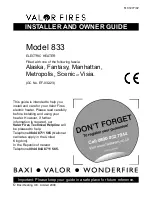
105
SERVICE PROCEDURES
ONLY AN AUTHORISED PERSON MAY REPAIR OR SERVICE A GAS APPLIANCE
Regular servicing must be performed to ensure maximum operating efficiency.
The daily and monthly maintenance as outlined below may be performed by onsite maintenance staff
however all other servicing MUST be performed by a suitably qualified tradesperson.
Daily
1. Check that the area where the heater is installed is free from combustible materials, chemicals and
flammable vapours and liquids.
2. Check for and remove any obstruction to the flow of combustion or ventilation air to heater.
Monthly
1. Check for presence of water leaks around pumps, relief valves, and other fittings. If any leaks are
detected, arrange for immediate repair.
2. Visually inspect burner flame through burner viewing window. It should be light blue at full input.
3. Visually inspect flue system for proper function, deterioration or leakage.
4. Visually inspect for proper operation of the condensate drain in the flueing. If leaks are observed,
arrange for immediate repair.
5. Check air vents for leakage.
The following
MUST
be carried out by a suitable qualified tradesperson
For peak performance it is suggested that the heater be serviced prior to the winter period where light
to medium hot water usage occurs, and six monthly where medium to heavy usage occurs.
If Servicing is performed only onc
e a year, conduct both the ‘Six Monthly Service Procedure’ and the
‘Annual Service Procedure’. If servicing is performed at six monthly intervals, rotate between the
‘Annual Service Procedure’ and ‘Six Monthly Service Procedure’.
Six Monthly Service
1.
Clean the cabinet of any dust, lint and debris.
2.
Ensure plants, shrubs or any other material are not obstructing the flue terminal or air intake / duct
(if an air intake duct installed) and check flue system and air intake / duct system to ensure they
are functional and not leaking.
3.
Inspect flue system condensate drain(s) to ensure it is not blocked and that condensate is being
directed to the appropriate area or drain.
4.
Check for signs of excessive corrosion on the outside and inside of the heater.
5.
Check for signs of leaking at pipe fittings and in/out header and header components.
6.
Operate the pressure relief valve (PRV) manually to check that the drain is clear and the valve
reseals.
7.
Check gas train for missing test point screws or damaged gaskets, and check air pressure hoses
to ensure they are correctly connected without kinks and that the test point cap is fitted.
8.
Check the inlet gas pressure.
9.
Check blower vacuum pressure and replace air filter if necessary (refer to
on page 106).
10. Check the manifold gas pressure.
11. Check to ensure the burner flame burns with a small light blue flame (at full fire) by looking through
the burner viewing window located on the bottom front of the heater (remove round black plug).
Remove and clean the burner if there is a tendency for yellowing of the flame (Propane and ULPG
models may exhibit a slightly yellow flame). The presence of soot accumulation indicates an
abnormal operating condition.
12. With the burner operating, close gas isolation valve and test operation of heater with no gas flow
to confirm its operation up to lockout stage.
Note:
When the gas is isolated, the burner should




































